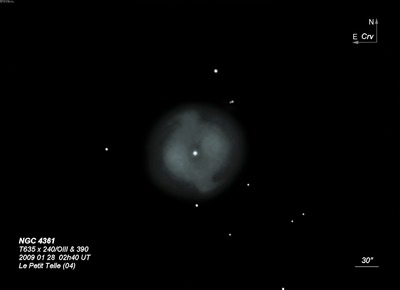
William Herschel discovered NGC 4361 = H I-65 = h1231 on 7 Feb 1785 (sweep 368) and recorded "vB, pL, mbM. The central brightness not round but as if it had two nucleuses pretty closely joined; the chevelure [halo] iR." John Herschel wrote, "vB, L, R, vsmbM to nucl = *11, 90" diameter. R[esolved] with power 320, and is no doubt a globular cluster; fades away to nothing. So, JH was convinced it was a globular. Surprisingly it was misclassified as a galaxy in de Vaucoleurs' 1st "Reference Catalogue of Bright Galaxies" (RC1)!
Based on Crossley photographs at Lick, Curtis described NGC 4361 as "central star about mag 10; this is surrounded by an irregular oval mass whose brighter parts are about 44"x39" in pa 103°. From this central portion two arms (spiral whorls?) go out in pa 20° and portions of a very faint ring 81" can just be made out." (1918PLicO..13...55C). Early photographs were taken with the 30-inch Reynolds reflector between 1912-14 at the Helwan Observatory near Cairo. The director Harold Knox-Shaw also described a "Round nebula 1' diameter from which proceed spiral arms."
300/350mm - 13" moderately bright, fairly large, slightly elongated. The mag 13 central star is fairly easy at 165x.
400/500mm - 17.5" (5/15/99): 100x easily reveals the bright central star surrounded by a moderately high surface brightness halo ~1' in size. At 220x, the central star appears 13th magnitude and the halo gradually brightens towards the center. With averted vision, the halo increases to roughly 90"x60", extended SW-NE, with an ill-defined edge. I had the strong impression of an extension or hook on the southwest end of the PN, which was confirmed on the DSS image (a similar extension is also on the NE end).
900/1200mm - 48" (5/3/19): at 488x; fascinating bright blue planetary with a very bright mag 13 central star. Unfiltered, the unusual feature are two opposite "handles" or thick arcs that are attached just outside the central region on the WNW and ESE sides. Adding a NPB filter, two arms or loops lit up on the SW and NE sides. These loops appeared similar to spiral arms attached to the main body and rotated counterclockwise!
48" (2/20/12): the unusual structure in this planetary shocked me at 488x as previous views in my 17.5" and 18" had only showed a hint of detail. The two main components are large bulbous lobes or wings with an irregular surface brightness that jut out of the central region in a WNW and ESE direction, with the WNW lobe slightly brighter. More surprising were two arms and loops, similar to spiral arms in a galaxy, that extend out to the NE and SW and curve clockwise. The arm to the southwest is very thin where it emerges from the central portion, so it appeared partially detached! The arm on the NE side clearly bends south but was not as sharply defined. Between the lobes (WNW and ESE) and arms (SW and NE) were darker gaps or regions creating a unique, basically symmetric shape that is elongated SW-NE (arms are longer), ~1.8'x1.4'. At the center is a very bright mag 13 central star. A fainter, more roundish halo envelops the brighter components.
Notes by Steve Gottlieb